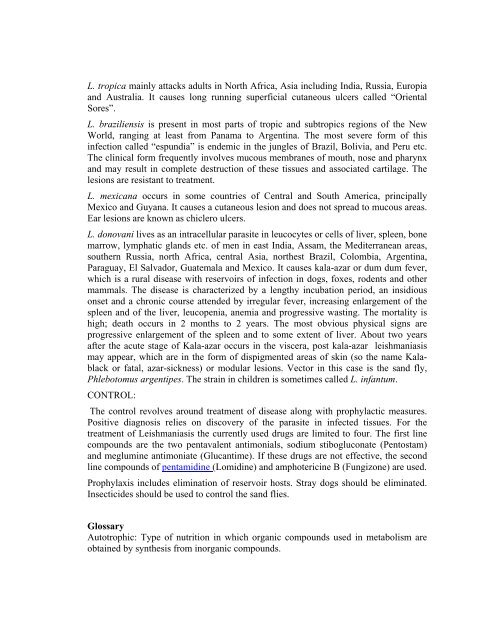ANIMAL DIVERSITY – I (NON-CHORDATES)
ANIMAL DIVERSITY – I (NON-CHORDATES)
ANIMAL DIVERSITY – I (NON-CHORDATES)
Create successful ePaper yourself
Turn your PDF publications into a flip-book with our unique Google optimized e-Paper software.
L. tropica mainly attacks adults in North Africa, Asia including India, Russia, Europia<br />
and Australia. It causes long running superficial cutaneous ulcers called “Oriental<br />
Sores”.<br />
L. braziliensis is present in most parts of tropic and subtropics regions of the New<br />
World, ranging at least from Panama to Argentina. The most severe form of this<br />
infection called “espundia” is endemic in the jungles of Brazil, Bolivia, and Peru etc.<br />
The clinical form frequently involves mucous membranes of mouth, nose and pharynx<br />
and may result in complete destruction of these tissues and associated cartilage. The<br />
lesions are resistant to treatment.<br />
L. mexicana occurs in some countries of Central and South America, principally<br />
Mexico and Guyana. It causes a cutaneous lesion and does not spread to mucous areas.<br />
Ear lesions are known as chiclero ulcers.<br />
L. donovani lives as an intracellular parasite in leucocytes or cells of liver, spleen, bone<br />
marrow, lymphatic glands etc. of men in east India, Assam, the Mediterranean areas,<br />
southern Russia, north Africa, central Asia, northest Brazil, Colombia, Argentina,<br />
Paraguay, El Salvador, Guatemala and Mexico. It causes kala-azar or dum dum fever,<br />
which is a rural disease with reservoirs of infection in dogs, foxes, rodents and other<br />
mammals. The disease is characterized by a lengthy incubation period, an insidious<br />
onset and a chronic course attended by irregular fever, increasing enlargement of the<br />
spleen and of the liver, leucopenia, anemia and progressive wasting. The mortality is<br />
high; death occurs in 2 months to 2 years. The most obvious physical signs are<br />
progressive enlargement of the spleen and to some extent of liver. About two years<br />
after the acute stage of Kala-azar occurs in the viscera, post kala-azar leishmaniasis<br />
may appear, which are in the form of dispigmented areas of skin (so the name Kalablack<br />
or fatal, azar-sickness) or modular lesions. Vector in this case is the sand fly,<br />
Phlebotomus argentipes. The strain in children is sometimes called L. infantum.<br />
CONTROL:<br />
The control revolves around treatment of disease along with prophylactic measures.<br />
Positive diagnosis relies on discovery of the parasite in infected tissues. For the<br />
treatment of Leishmaniasis the currently used drugs are limited to four. The first line<br />
compounds are the two pentavalent antimonials, sodium stibogluconate (Pentostam)<br />
and meglumine antimoniate (Glucantime). If these drugs are not effective, the second<br />
line compounds of pentamidine (Lomidine) and amphotericine B (Fungizone) are used.<br />
Prophylaxis includes elimination of reservoir hosts. Stray dogs should be eliminated.<br />
Insecticides should be used to control the sand flies.<br />
Glossary<br />
Autotrophic: Type of nutrition in which organic compounds used in metabolism are<br />
obtained by synthesis from inorganic compounds.
















